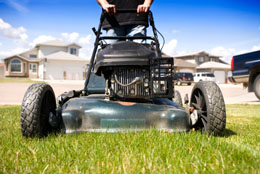Growing and maintaining a healthy, lustrous green turf lawn requires you to be aware about the basics like irrigation, mowing, aerification, fertilization, and dethatching. This article gives you effective pointers on maintaining a turf lawn in the best possible way.

For many landscapers, an ideal landscape consists of a well-maintained turf grass lawn along with other garden components. A healthy turf lawn increases the aesthetic value of the landscape making the surroundings more appealing. Scientifically, it is proved to be very effective in maintaining high humidity and cool temperature conditions. It reduces the dust and other pollutants in the surrounding areas. Alternatively, it also reduces soil erosion during the rainy season.
The quickest method to get a ready lawn is making use of turf grasses. Laying it is easy if you follow these instructions. Start preparing the laying site during spring or early winter. Lightly spray farmyard compost at least a few days before laying the turves. Once delivered to you, lay the turves as soon as possible before the grasses turn yellow.
Another option is to start right from the beginning, and use turf grass seeds. You can purchase individual seeds of a particular grass type or a mixture of seeds containing different grass varieties. For sowing the grass seeds, prepare the soil as you do for other plantations. Sow seeds as per the guidelines provided for the grass variety.
The thumb rule for a lustrous green, healthy turf lawn is to maintain proper soil moisture. Depending upon the soil type, climatic conditions, and grass variety, water it carefully. The other things that should be taken care of are mowing, aerification, fertilization, dethatching, and diagnosing other turf grass problems.
Irrigation
Watering should ideally be done early in the morning. The amount of water used should be such that it wets the root zone. Too less irrigation may lead to drying and yellowing of the grasses, whereas a waterlogged condition causes rotting of the roots, that ultimately causes their death.
Mowing
A turf lawn that has just been laid, should not be mowed for the first few weeks. As the turves begin to grow, you can mow by setting the lawn mower at a high level. The mowing height (an average of 3 inches) and frequency may vary based on the turf grass variety. Proper mowing with sharp blades enhances the appearance of the lawn.
Aerification
Aerification refers to the loosening of soil compactness with the help of aerifiers. It increases the air circulation, rooting, water absorption, and at the same time, reduces the thatch accumulation. Aerification is mostly recommended for compacted soil during the spring and fall seasons.
Fertilization
Sparse fertilization with about 2 - 4 pounds of nitrogen fertilizer per 1000 square feet per year is sufficient for turfs in cool climatic conditions. Heavy dose of fertilizers, about 4 - 5 pounds, is used in turf lawns that experience high traffic, for example play areas. Appropriate fertilization time is during summer, when the grasses assimilate the maximum nutrients.
Dethatching
Dethatching refers to removal of the organic layer accumulated just above the soil. Thatch includes living and dead shoots, leaves, and roots. It gets accumulated due to over-fertilization and/or over-irrigation in the turf lawn. Occasional dethatching with the help of appropriate machines is recommended to maintain a healthy lawn.
Turf Problems
Speaking about turf problems, the susceptibility of each kind of grass towards diseases and pests is different. The best method is to determine the common pest and diseases in your area and select tolerant grass varieties. You can control weeds effectively by mowing the lawn properly. If necessary, you can use appropriate chemical pesticides and herbicides after consulting a landscape professional.
If you are passionate about landscaping, you can pursue a career in turf management. Nowadays, there are certain agricultural institutes that offer such courses. The turf management sector is blooming just like the landscape sector.






 For many landscapers, an ideal landscape consists of a well-maintained turf grass lawn along with other garden components. A healthy turf lawn increases the aesthetic value of the landscape making the surroundings more appealing. Scientifically, it is proved to be very effective in maintaining high humidity and cool temperature conditions. It reduces the dust and other pollutants in the surrounding areas. Alternatively, it also reduces soil erosion during the rainy season.
For many landscapers, an ideal landscape consists of a well-maintained turf grass lawn along with other garden components. A healthy turf lawn increases the aesthetic value of the landscape making the surroundings more appealing. Scientifically, it is proved to be very effective in maintaining high humidity and cool temperature conditions. It reduces the dust and other pollutants in the surrounding areas. Alternatively, it also reduces soil erosion during the rainy season.